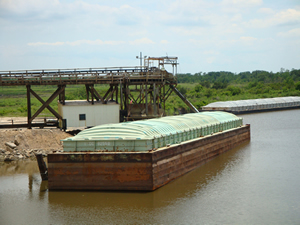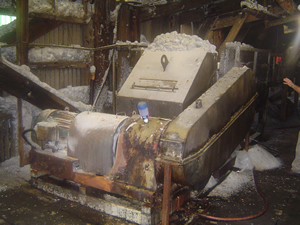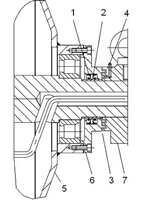

|
|
© 2015 by RULMECA Corporation |
|
Rulmeca Problem-Solving Tips: CORROSION
|
|
Several major US salt mines have converted their belt conveyor belt drives from exposed systems to Rulmeca Motorized Pulleys. |
|||
 Cargill Deicing Salt Mine & Barge Terminal:
In the swampy region of Louisiana, Cargill Deicing operates a salt mine and barge loading terminal. The deep mine has battled the effects of corrosion and abrasion since the mine shaft was first sunk into the huge salt dome in 1862. However, it was not until Everett McBride first tried Rulmeca Motorized Pulleys in the barge loading system in 2004 that the company began seriously converting their exposed conveyor drive systems to internally-powered conveyor drive pulleys. Cargill Deicing Salt Mine & Barge Terminal:
In the swampy region of Louisiana, Cargill Deicing operates a salt mine and barge loading terminal. The deep mine has battled the effects of corrosion and abrasion since the mine shaft was first sunk into the huge salt dome in 1862. However, it was not until Everett McBride first tried Rulmeca Motorized Pulleys in the barge loading system in 2004 that the company began seriously converting their exposed conveyor drive systems to internally-powered conveyor drive pulleys.
|
|||
 Cargill Deicing (After):
Now the mine enjoys higher system reliability and lower maintenance expense because the Rulmeca Pulleys enclose all drive components within an oil filled hermetically-sealed pulley shell. Rather than struggling to protect moving components, Cargill “hides” them out of harm’s way. Cargill Deicing (After):
Now the mine enjoys higher system reliability and lower maintenance expense because the Rulmeca Pulleys enclose all drive components within an oil filled hermetically-sealed pulley shell. Rather than struggling to protect moving components, Cargill “hides” them out of harm’s way.
|
|||
 Cargill Deicing (Before):
Operations and maintenance personnel use stainless steel, special paint, and wooden structures to combat corrosion due to salt accumulation in the humid Louisiana marshlands. As shown in the photo taken before the exposed drive system was removed, salt accumulation on metal surfaces caused corrsion problems and plugged motor cooling fins and fans.
Cargill Deicing (Before):
Operations and maintenance personnel use stainless steel, special paint, and wooden structures to combat corrosion due to salt accumulation in the humid Louisiana marshlands. As shown in the photo taken before the exposed drive system was removed, salt accumulation on metal surfaces caused corrsion problems and plugged motor cooling fins and fans.
|
|||
 Motorized Pulley Labyrinth Seals:
Special features incorporated into the Cargill Motorized Pulleys include inorganic zinc rich primer, 12 mils of Carboline Carbomastic CM15FC paint, regreasable labyrinth seals, and stainless steel shafts. The paint system protects steel and cast iron surfaces while the labyrinth seals provide a grease barrier to protect all double lip shaft seals. In addition, Class H motors and synthetic oil protect the drive system from the heat of the Louisiana marshland climate.
Motorized Pulley Labyrinth Seals:
Special features incorporated into the Cargill Motorized Pulleys include inorganic zinc rich primer, 12 mils of Carboline Carbomastic CM15FC paint, regreasable labyrinth seals, and stainless steel shafts. The paint system protects steel and cast iron surfaces while the labyrinth seals provide a grease barrier to protect all double lip shaft seals. In addition, Class H motors and synthetic oil protect the drive system from the heat of the Louisiana marshland climate.
|
|||
|
|